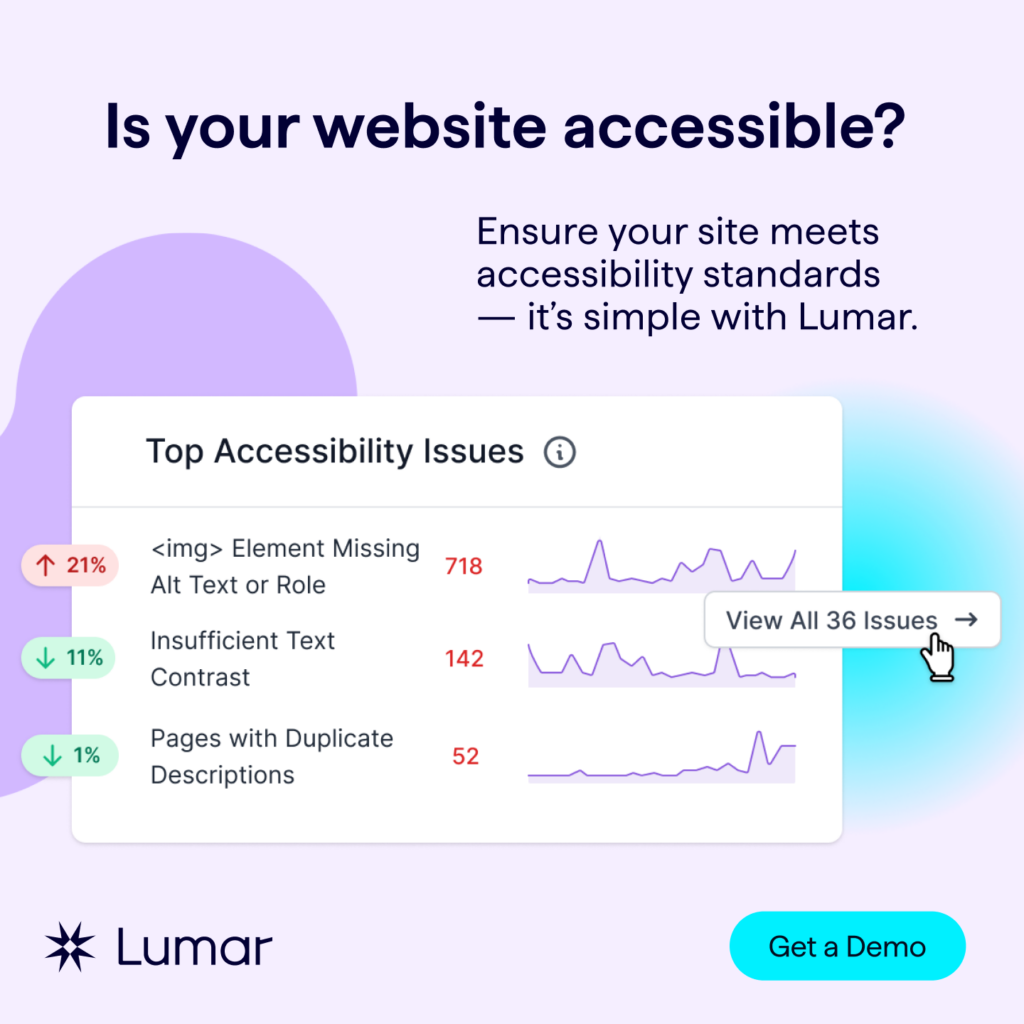New European Accessibility Act (EAA) regulations will go into effect in June 2025. The EAA includes considerations for digital accessibility — this means many websites that operate in (or sell products or services within) the EU will need to ensure they have proper web accessibility best practices in place.
Here, digital accessibility consultant Carter Temm provides an overview of the upcoming EAA regulations — and tips on how to start ensuring your website will be compliant with the new rules in 2025.
A brief history of European accessibility law
In Europe, the last two decades have seen major strides toward equality of people with cognitive and physical impairments.
It began in 2000 when the European Union Council met to establish the Employment Equality Directive, a generalized framework to prohibit workplace discrimination on the basis of disability, age, gender, and other identifying factors.
In 2011, the EU and each of its member states signed the UN Convention on the Rights of Persons with Disabilities (UNCRPD). This was a significant milestone in that it represented a formal acknowledgment that “persons with disabilities have the same rights as everyone else”, and a commitment to protect these rights. Furthermore, article 9 of the convention mentions provisions for access to information and communications technology (ICT).
While the commission worked to ratify this treaty, they were also involved in outlining steps to implement it practically in what became known as the European Disability Strategy 2010-2020. This strategy ultimately led to the passing of the 2016 web accessibility directive (WAD), which states that public sector bodies must make their websites and applications accessible. To support this effort, the European Standard EN 301 549 was updated in 2018, providing detailed technical standards for ICT accessibility not unlike section 508 in the United States.
What is the European Accessibility Act (EAA)?
The European Accessibility Act (EAA), officially known as Directive – 2019/882, is a landmark piece of legislation aimed at ensuring that the estimated 80 million people with some degree of disability across the European Union can access a wide variety of physical and digital products and services outside the public sector.
As a directive, the EAA is not itself a law. Instead, it is a legislative act that defines a minimum set of goals and requirements. The burden lies with each country (or member state) to devise its own laws that businesses must follow.
The act was established to circumvent some limitations of the status quo:
- Reduction of fragmentation. Prior to the EAA, different member states had their own sets of laws and regulations (and a few had none at all). This inconsistency made it difficult to understand what businesses needed to do when it came to establishing and maintaining compliance, especially those that operate across borders.
- Limited scope. While the web accessibility directive addressed digital accessibility for government authorities, many companies in the private sector continue to create products without considering the needs of users with cognitive and physical impairments.
- Increased market opportunity. By harmonizing the rules at play, the EAA effectively creates a large-scale market of inclusive products, the impact of which will be felt around the world. This appears to have been an objective: the commission actually makes a point of noting that the EAA takes into account the obligations deriving from the UN Convention on the Rights of Persons with Disabilities.
- Fostering innovation. With the requirement that certain categories of products now need to be accessible (there is no longer a choice), competition will lead to accessible products and services at more reasonable prices. Additionally, companies will be forced to come up with new and creative ways to make their offerings work for everyone.
In essence, from Annex 1 of the Directive: “The demand for accessible products and services is high and the number of persons with disabilities is projected to increase significantly. An environment where products and services are more accessible allows for a more inclusive society and facilitates independent living for persons with disabilities.”
Who must comply with EAA website regulations?
The vast majority of businesses that are based in — or that wish to operate in — the EU need to take steps to ensure their products meet accessibility standards, if they haven’t already.
Unlike most other accessibility regulations, the EAA makes it exceedingly clear: even if you don’t physically reside in Europe, even if you only rarely provide services or ship packages there, you still have to take accessibility into account.
There are a few minor exceptions to EAA compliance rules:
- Microenterprises: Companies that have fewer than ten employees and a turnover below €2 million are immune, for now.
- Undue burden: Companies that can demonstrate ways in which compliance would be unachievable, either on account of technical impracticalities or significant financial hardship, do not have to abide by this rule. It is worth noting that the burden of proof lies on the company and is a high one, involving a thorough assessment of costs vs benefits, company size/resources, and the duration and frequency of use for a given product or service.
What products are included in EAA guidelines?
The European Accessibility Act covers a wide range of products and services focused around key areas of daily life.
Here’s a detailed list of what types of products and services are included in the EAA guidelines (from Annex 1 of the Directive, linked above):
- computers and operating systems: including consumer general-purpose computer hardware systems like laptops, smartphones, and tablets but excluding specialized computers embedded in consumer electronics or single components with specific functions
- ATMs, payment terminals, ticket dispensers, ticketing and check-in machines (excluding certain interactive self-service terminals that are built-in to vehicles, aircrafts, ships, or rolling stock)
- TV equipment related to digital television services: including the ability to turn on features that might help someone interpret multimedia content such as audio descriptions, captions, subtitles, and sign-language interpretation. The implementation of these features is covered by the applicable standard.
- telephony services and related equipment
- access to audio-visual media services such as television broadcast and related consumer equipment
- services related to air, bus, rail, and waterborne passenger transport
- banking services
- e-books: including interoperability and compatibility with current and future assistive technologies
- e-commerce, i.e. websites that facilitate the sale of a product
EAA implementation timeline: prepare for June 2025
The EAA’s implementation follows a measured rollout timeline. While the act was adopted back in 2019, a transition period was built in so that everyone has the opportunity to adapt without service disruptions. Next year, in June 2025, all new products (or updates to existing products) that fall within the stated EAA purview (see above) will need to comply with the accessibility rules.
Here’s what you should know:
- Previously, EU member states had until June 2, 2022 to transpose the provisions of the directive into national law and inform the commission.
- Each of these laws go into effect starting on June 28, 2025. However, there is an allowance that would allow member states to extend this deadline by two years to June 28 of 2027, as outlined in article 31 of the directive linked above.
- By June 28, 2025, for all member states that have not exercised the above exemption, all new products or updates to existing products need to conform to the accessibility regulation(s) outlined in the corresponding member state legislation.
- By June 28, 2030, all existing products that are still supported need to have been brought in line with relevant accessibility regulation(s).
Though it is likely that some nations will choose to push the compliance date out to 2027, we highly advise against banking on that—it’s just too difficult to know at this point in time.
Assuming this information were to come to light, and you only operate in a nation that has exercised the exemption, there is also a well-documented fact to contend with. The longer you wait, the more costly accessibility implementation becomes later on.
What are the consequences of EAA non-compliance?
While the EAA leaves the repercussions up to each member state to decide upon individually, the commission uses this verbiage to establish constraints:
“Penalties shall take into account the extent of the non-compliance, including its seriousness, and the number of units of non-complying products or services concerned, as well as the number of persons affected.”
They also say: “The penalties provided for shall be effective, proportionate and dissuasive. Those penalties shall also be accompanied by effective remedial action in case of non-compliance of the economic operator.”
Put differently, at least one (and likely more than one) of the following may happen depending on the circumstances:
- Monetary loss (most member states have instituted hefty fines depending on the location, nature of the violation, and size of the business)
- Imprisonment following repeated infractions for individuals in certain positions, currently limited to Ireland
- Ineligibility for government contracts
- Reputational damage, bad press, and consumers choosing to take their business elsewhere
- Loss of customers with disabilities, who collectively have tremendous spending power
- Lawsuits, settlements, and legal fees
- Swift and corrective actions, which could involve costly redesigns, updates, or recalls that can be extremely jarring if they’re not planned for ahead of time.
It’s important to note that the EAA does include provisions for constructively addressing non-compliance, affectionately called “alternative dispute resolutions mechanisms.” Essentially, authorities may choose to notify entities and give them a reasonable resolution timeframe prior to imposing penalties. The severity and extent of these penalties are likely to depend on factors such as the degree of non-compliance, the impact on accessibility, the size of the company, and the company’s efforts to address the issues.
What website regulations are in place within the EAA?
The EAA itself doesn’t explicitly call out a standard to conform to when it comes to website accessibility; it leaves that up to the regulations that member states need to come up with.
It does, however, call out the four POUR principles common in digital accessibility as defined by version 2 of the Web Content Accessibility Guidelines (WCAG). These principles are:
- Perceivability: Information and user interface components must be presentable to users in ways they can perceive.
- Operability: User interface components and navigation must be operable.
- Understandability: Information and the operation of the user interface must be understandable.
- Robustness: Content must be robust enough to be interpreted reliably by a wide variety of user agents, including assistive technologies.
Worth noting is the fact that all accessibility regulations in use around the world loosely follow the evolution of the WCAG. So far, the legislation seems to point to EN 301 549, which extends the WCAG.
Which WCAG level must website managers adhere to under the EAA guidelines?
Since the EAA doesn’t get specific on this, it is best to consult the laws present in the specific EU nations that you operate in. However, in the interest of staying relevant, it is a fair assumption that WCAG 2.2 level AA will be the standard to aim for as a minimum. If additional requirements are present, this will get you 95% of the way there.
Conclusion and tips on getting started
The European Accessibility Act represents a significant step towards creating a more inclusive digital landscape across not just the EU, but the world at large. As we’ve explored, it impacts most businesses in the private sector.
Ensuring your digital offerings are EAA compliant can definitely seem daunting, but the best time to begin is right now. Here are a few actionable steps and places to concentrate your efforts.
- Define the objective. You want to become accessible, but what does that mean exactly? Consult the laws and regulations in each of the member states where you operate. Take note of the similarities and differences between these provisions. Use the highest standard that is required as your conformance minimum. If you don’t know for sure, WCAG 2.2 level AA is probably the best bet.
- Build knowledge. Accessibility expertise is critical for any team working on applications, software, and websites in the 21st century. Start out with resources like the W3C’s articles, new-to-digital accessibility resources, and the “Understanding WCAG” documents.
If you prefer video-based learning, the community routinely hosts webinars on a variety of accessibility topics for all skill and experience levels.
Once you feel up to the task, begin by running an automated assessment on your digital property through an entry-level free tool like WAVE, axe DevTools, or Lighthouse.
- Since automated tools can only detect a small percentage of the barriers your users are likely to actually face, utilize the Test & Evaluation resources by W3C, including their Easy Checks list, to do some self-testing.
If you have a significant number of pages to review or a large or complex website, it may be advantageous to use more robust accessibility tools like Lumar’s web accessibility platform or engage an established team of professional accessibility specialists that incorporates people with cognitive and physical impairments, like QualityLogic.
- Remediate and iterate. Work to resolve the issues that were found. Continue educating stakeholders throughout all roles in the SDLC (from designers to developers and QA specialists) so they can incorporate accessibility into the work that they do, leading to fewer issues overall.
Remember, accessibility is a process. It’s a journey of continuous learning and reflection, not a destination. By starting today and making consistent progress through wins over time, you’ll be well-positioned to not only meet the requirements of the EAA but reap the many benefits inherent in supplying accessible products and services.
If at any point you get stuck, our teams have ample expertise in helping organizations take their first steps with digital accessibility. We’d love to chat about your objectives and help get you moving in the right direction!








